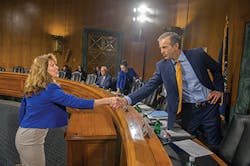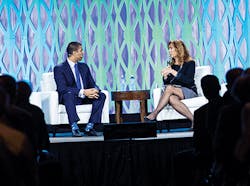Executive Insights With Shirley Bloomfield, CEO, NTCA–The Rural Broadband Association
Topic: NTCA Priorities.
ISE magazine: What are NTCA’s 2020 priorities for your rural members? What is going to "move the needle" for them, related to network transformation and the ability to deliver what end users demand in today’s hyper-connected society?
Bloomfield: We are really encouraged by the attention being paid to rural broadband in the last several months, including the announcement in spring 2019 about the FCC’s creation of the Rural Digital Opportunity Fund (RDOF). So, in 2020, our priority is to ensure that programs like RDOF are implemented in a way that promotes future-proof network deployment.
Accurate broadband mapping practices, of course, have a role to play too, and we have and will advocate for more granular mapping, standards for reporting, and competitive overlap challenge processes. Additionally, the federal support programs that enable broadband deployment in rural America are critical to its success. So, contributions reform will be key to ensure the future viability of these programs.
Last, but certainly not least, is trying to bring different business opportunities to the table for our member companies. What role can we play in connecting the dots between different opportunities, and getting the right players around the table to look at ways to generate new streams of income? I find that possibility exciting!
InvisiLight® Solution for Deploying Fiber
April 2, 2022Go to Market Faster. Speed up Network Deployment
April 2, 2022Episode 10: Fiber Optic Closure Specs Explained…
April 1, 2022Food for Thought from Our 2022 ICT Visionaries
April 1, 2022Topic: Network Testing
ISE: In late October 2019, NTCA met with staff from the offices of FCC Chairman Ajit Pai, Commissioner Jessica Rosenworcel, and Commissioner Geoffrey Starks, on Performance Testing. NTCA expressed appreciation for the pre-testing and testing schedule, and reiterated its support for the usefulness of network testing. NTCA also expressed to the Commission the need to ensure protocols be implemented in ways that are both administratively and economically equitable and efficient. Why are these measures important? What are specific recommendations NTCA has to do this?
Bloomfield: While we agree that performance testing is useful, it is equally important to implement it appropriately. Right now the requirement for providers to test from the customer premises to a remote test server reached by passing through a Commission-designated IXP is worrisome and a bit unfair.
That holds NTCA member companies to a standard for a part of the network they are not responsible for — like someone getting a speeding ticket when the cab driver is the one with their foot on the gas pedal.
Topic: 5G
ISE: What important things must rural providers do to help advance 5G?
Bloomfield: There will be no 5G without a fiber network because 5G is a fiber-fed product. Right now, over 60% of customers served by NTCA members have fiber-to-the-home and, even still, we are aiming higher.
Streaming video and other data demands enabled by 5G will test and strain spectrum resources and networks. Promised speeds therefore won’t be realized without significant underlying fiber capacity — and in rural areas, the practical reality is that it’s going to take fiber to nearly every home and business to make 5G work as it does in urban areas.
Fortunately, NTCA members haven’t taken their eyes off the prize. While they use every possible technology to reach consumers in need of service now, they have stayed focused on the ultimate goal of building networks for the long haul: networks that will both respond directly to increasing consumer demand for high-speed broadband and enable evolving complementary 5G services. Meanwhile, we have some parts of rural America waiting for "Any Gs", so expectations need to be realistic as well.
NTCA CEO Shirley Bloomfield greets U.S. Senator John Thune (R–SD) before the Senate Commerce Committee hearing Connecting America: Improving Access to Infrastructure for Communities Across the Country.
Topic: Women in Telecom
ISE: Despite many efforts, the Telecom/Information and Communication Technology (ICT) industry is still lacking when it comes to executive leadership by women. Why is that, and what can we do about it?
Bloomfield: Traditionally the path to leadership in telecom organizations progressed through the engineering side of the house, which was a male-dominated field. (Although that is changing!) The recent emphasis on STEM education for young girls will go a long way in re-setting gender diversity in the industry.
That being said, engineering is not the only field that produces great technology business leaders. Business acumen (making the case for deployment, understanding financial resources needed to do the job well, etc.) is key to success, especially for broadband deployment in rural areas. I find that women who work on the financial aspects of business have a very good gut for leading on critical business decisions.
I have personally found it very rewarding to create and participate in various networking opportunities with other women leaders. At NTCA we launched our Women in Telecom network to allow women leaders to share, support, and compare, career and management advice with one another. I have a similar group of women I work with at GlobalWin, a group I helped organize in D.C. with other female leaders in various tech industries, and we share those same opportunities from a national perspective.
As Eleanor Roosevelt famously said: It is better to light a candle than curse the darkness. We all have a role to play in putting out a helping hand to that next generation of leaders. I certainly owe that much to my 2 amazing daughters!
Topic: Rural Network Speeds
ISE: What are some answers to delivering higher-speed broadband to rural communities? What can the vendors supporting rural providers do to help this?
Bloomfield: Invest in futureproof technology. We cannot look to just "patch a hole" or "fill in the gap." Go in and do it right the first time; it is far more cost-effective, and it matches what consumer demand is telling us. They want faster broadband on more devices, and the multiplier effect will not slow down.
As the government makes broadband buildout a priority and invests in deployment in terms of infrastructure, support programs have to incentivize the most future-proof technology for their long-term viability. The vendor community is terrific about lending their expertise, advice, and counsel, and we’re seeing the proof of that good work with the number of NTCA members receiving the inaugural USDA ReConnect funding, announced as 2019 drew to a close.
Topic: Overlooked Issues
ISE: What should all of us in the ICT industry be talking about that we are not? What current topic is the most important that needs additional and different attention?
Bloomfield: Dispel the myth that rural America is disconnected. Yes, we need to connect rural America more than ever, but a significant portion of rural America is already connected, thanks to community-based providers. As community-based entities, their focus is always on serving the area where they themselves live, work, and play, as well as the economics will allow.
What you see is not simply a rural/urban divide, but a divide between rural areas themselves — between those who have lightning-fast broadband speeds in their community of 3,000, and those who perhaps are served (or not served) by some of the larger companies out there who, quite frankly, have shareholder pressure to put their resources into more lucrative markets with larger returns on the investments.
We know where the problem is. Now we just need to incentivize companies, like NTCA members, to be part of the solution by edging out even further to bring service in collaborative ways to these underserved areas outside of their existing current markets.
FCC Chairman Ajit Pai and NTCA CEO Shirley Bloomfield discuss the future of rural telecommunications at RTIME 2019.
Topic: Being All Things to All Users
ISE: A significant challenge for service providers today is the need to simultaneously service customers on everything the "big guys" do. What is your advice to rural telecom providers to address this challenge?
Bloomfield: Be real about what you’re good at. We look at the increased importance of a mobility play. Rural operators just cannot compete with the "big guys" on spectrum and market share. Know the market and know your sweet spot. Use your time, energy and resources in areas where you can excel. Customer service, for instance. NTCA member companies serve their customers really well, and we hear about it. NTCA members take pride in their work, and care about their customers because they are their neighbors and friends.
Topic: Smart Smaller Cities
ISE: How can rural providers work with their cities and towns to help them develop comprehensive smart city initiatives? Share your greatest learnings about the smart cities’ and telecom providers’ interconnected relationship, and how it needs to change in the future.
Bloomfield: Smart cities — or, as we call them, Smart Rural CommunitiesSM — are not just connected streetlights and driverless cars; they are networks of local residents and organizations prioritizing connectivity for the students, patients, and business owners, in their communities. Broadband providers can educate their community members on all the ways that connectivity changes lives (from telemedicine to social media to operating a global business in a small, rural town).
This is also a terrific opportunity to further the adoption rate for broadband in rural communities when the lightbulb goes off that advanced communications is about more than just faster email delivery.
What I know about Smart Rural CommunitiesSM and the broadband providers that support them is that relationships matter. Taking the time to connect with communities and community members creates buy-in for these endeavors.
Topic: Guidance
ISE: What professional and leadership guidance would you offer a younger Shirley as she was forging her career path?
Bloomfield: The first is: don’t take things so personally. Learning early how to take constructive advice is very important, because I do think viewing that feedback as a gift helps you to reflect and grow.
The other: follow your passion. I do what I do working with rural broadband providers because I’m passionate about it — passionate about the people I represent, and about the amazing work they do in their communities. The twists and turns in my career have nearly always been in the telecom arena, but I did not always feel like I was making a difference in people’s lives in larger corporations. I knew I wanted to make a difference, so I sought experiences and roles where that was possible.
Now, at NTCA, I see it each and every day through our incredible member stories. I think my entire team feels the pride and satisfaction of a job well done when we see those communities receiving broadband for the first time, or when a telehealth clinic is established in a member’s service territory. I recently shared with them the story from a farmer in Iowa about how broadband monitoring and online marketing has changed his operation and his business model, and how he can now hand the farm down to his son.
NTCA CEO Shirley Bloomfield and United States Secretary of Agriculture Sonny Perdue (second from right) share thoughts on the political climate and policy initiatives at the NTCA 2019 Fall Conference.
Topic: Agility
ISE: A business needs to run 2 models simultaneously: one optimized for today, and one optimized for tomorrow. How do you do that well without neglecting one or the other?
Bloomfield: I have a great team. Our board leadership is heavily involved on all levels. They spend time focused on both the operational aspects of NTCA, but also always create time for big-picture thinking, and our terrific staff allows us to pursue both.
We have also always had an established group of great thinkers from our membership that we pull together at least a few times a year to be thinking about where the industry is heading and how we best help companies prepare. Their last product was called A Practical Guide to Charting One’s Own Course. It focused on various challenges and issues faced by rural operators, case studies of recent successes and failures, and the continuing evolution and cultural shifts of telcos as they transition from "order takers" in an environment where customers had only one place to go for their telecom services, to aggressive "order getters" that proactively plan new service offerings, market those offerings in creative ways, and look to differentiate themselves from would-be competitors.
Topic: Failure
ISE: How do you embrace failure, and encourage risk-taking across your organization?
Bloomfield: I do it in practice. I am a big believer in trying new things, and make it very clear to our team that I embrace that. And I don’t view things not working as a failure. What I think is a failure is to do the same thing over again without recognizing that it did not work.
For instance, right now we are in the middle of a digital transition, moving almost all of our operations and communications online in an effort to meet our members where they are and where they’re going. It’s a big step forward and a big change!
On that note, no one is punished for trying and failing. You cannot say enough to people Let’s give it a try. I say If it doesn’t work we’re going to pivot. And What did we learn from this? And tweaking is not failing!
Topic: Balance
ISE: What do you do to help create work/life balance in your life?
Bloomfield: I try very consciously to find one thing a day that will give me a belly laugh. One thing a day that I can find humor in. It keeps me grounded. Also, because I’m on the road a fair amount I try not to deprive myself. If I smell great fries going through an airport I might grab them. But I also do try to squeeze exercise in when I can, and have even gone digital myself with The Mirror, a home fitness system that allows me to guilt myself into working up a sweat if I don’t make it to the gym. And now that my children are grown, there are the dogs.
Topic: Mentoring
ISE: What hands-on things should good mentors do?
Bloomfield: To be a good mentor you have to be your best at listening. Sometimes when people say they want to mentor they want to share stories of their success and their path, but the better thing to do is check that at the door and simply listen.
You also have to be willing to share some constructive feedback. Too often mentors share the easy stuff but if you really do the listening you can more purposely give people the hard nugget. And that hard nugget is where the true value lies. Giving someone constructive advice and counsel means you care about that employee because you want them to grow and improve.
In that regard, I am really energized by our Women in Telecom initiative, which supports a mentoring program for women in the industry. We already have several women who volunteered to mentor, to be mentees, and also, something I think is great, women who want to do both.
Like this Article?
Subscribe to ISE magazine and start receiving your FREE monthly copy today!
About Shirley Bloomfield
Shirley Bloomfield is CEO of NTCA–The Rural Broadband Association. With 30 years of experience representing the country’s smallest independent telecom operators, Bloomfield is an expert on the role of federal communications policies in sustaining the vitality of rural and remote communities and the benefits rural broadband networks bring to the national economy. You can read Shirley’s blog, Broadband Beat, at https://ceoblog.ntca.org/. She can also be reached at [email protected]. For more information, please visit https://www.ntca.org/.
About the Author
Sharon Vollman
Content Ambassador for ISE EXPO
Sharon Vollman is the Content Ambassador for ISE EXPO. She is passionate about collaborating with thought leaders, SMEs and hard-working doers who design, plan and deploy ultra-reliable broadband networks. Vollman is committed to creating a variety of educational offerings for ISE EXPO attendees that inspire them to connect every U.S. citizen with the broadband networks we all want for our children and grandchildren.
Vollman has created educational partnerships with Broadband Service Providers including AT&T, Verizon, Lumen, Frontier Communications and others. She has covered the telecom industry since 1996.








